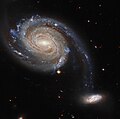Sary:NGC7752, NGC7753 - HST - Potw2142a.jpg

Haben'ny topi-maso: 604 × 600 teboka. Habe hafa: 242 × 240 teboka | 483 × 480 teboka | 774 × 768 teboka | 1 031 × 1 024 teboka | 2 063 × 2 048 teboka | 3 908 × 3 880 teboka
Rakitra niaviana (3 908 × 3 880 teboka, haben'ilay rakitra : 3,2 Mio, endrika MIME : image/jpeg)
Tantara ny rakitra
Tsindrio eo amin'ny daty/ora iray mba hijery ny toetra n'ilay rakitra tamin'io fotoana io.
| Daty sy ora | saritapaka | Habe | Mpikambana | resaka | |
|---|---|---|---|---|---|
| ankehitriny | 18 Oktobra 2021 à 05:11 |  | 3 908 × 3 880 (3,2 Mio) | Fabian RRRR | == {{int:filedesc}} == {{Information |description={{en|1='''Invisible Galactic Gale NGC 4666 takes centre stage in this image from the NASA/ESA Hubble Space Telescope. This majestic spiral galaxy lies about 80 million light-years away in the constellation Virgo, and is undergoing a particularly intense episode of star formation. Astronomers refer to galaxies which are forming stars anomalously quickly as starburst galaxies. NGC 4666’s starburst is thought to be due to gravitational interact... |
Fampiasana an'io rakitra io
Mampiasa ity rakitra ity io pejy io:
Fampiasan-drakitra maneran-tontolo
Mampiasa ity rakitra ity ireo wiki hafa ireo:
- Fampiasana eo amin'i ar.wikipedia.org
- Fampiasana eo amin'i az.wikipedia.org
- Fampiasana eo amin'i be.wikipedia.org
- Fampiasana eo amin'i ce.wikipedia.org
- Fampiasana eo amin'i de.wikipedia.org
- Fampiasana eo amin'i diq.wikipedia.org
- Fampiasana eo amin'i en.wikipedia.org
- Fampiasana eo amin'i eu.wikipedia.org
- Fampiasana eo amin'i fa.wikipedia.org
- Fampiasana eo amin'i fr.wikipedia.org
- Fampiasana eo amin'i mk.wikipedia.org
- Fampiasana eo amin'i ru.wikipedia.org
- Fampiasana eo amin'i sk.wikipedia.org
- Fampiasana eo amin'i tt.wikipedia.org
- Fampiasana eo amin'i www.wikidata.org
